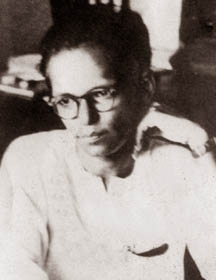
Ananda Samarakoon - The composer of our national anthem
Who composed our national anthem? I am sure all you readers know the
answer - Ananda Samarakoon. What do you know about him? We seldom hear
or read about him now. He died 44 years ago, on April 5, 1962.
'Sri Lanka Maatha' was not composed as the national anthem.
Samarakoon has put it on record that he composed it in 1940, when he was
a teacher at Mahinda College, Galle, to instil patriotism - a love for
one's country - in his students.

We had no national anthem to sing, on February 4, 1948, the day we
got independence from British rule. The need for a national anthem was
keenly felt; so, a competition was held to select one. Many choirs
trained by reputed musicians competed. Ananda Samarakoon's song was
selected. The Cabinet accepted 'Namo Namo Maatha' as our national anthem
on November 22, 1951.
The opening words of the original song were 'Namo Namo Maatha'.
Samarakoon knew nothing as he was away in India, holding art
exhibitions, when all this took place.
Samarakoon was not only a master musician, singer and lyric writer
(verses written to be sung are called lyrics), he was also an artist.
His paintings, which were exhibited in North India and in Singapore and
Malaysia during 1948-1951 had very favourable reviews in the leading
papers of those towns like Straits Times and Deccan Herald.
He showed his inborn talents in the field of music when he was still
a schoolboy. The story goes that he hated arithmetic. One day, the
master caught him writing some lines of verse instead of doing his sums.
"What is this?" asked the angry master. "A song", replied the boy.
"Then sing it for the class to hear", ordered the master, as a
punishment. The boy sang the words to a tune he made up on the spot. The
class was thrilled. The master's anger gave way to surprise and delight,
but he didn't show it. The song was about the beautiful river-side he
passed daily as he walked to and from school.
Ananda Samarakoon was born on January 13, 1911 in a small village,
Liyanwela, near Watareka in the Padukka area. His parents, Samuel
Samarakoon and Dominga Pieris were Christians. The son was christened
George Wilfred. His full name was Egodahage George Wilfred Alwis
Samarakoon.
He started schooling at the Wewala Government Sinhala school and his
daily walk from Liyanwela to Wewala and back, was past the Weraha Ganga,
which as it goes downstream, becomes the Bolgoda Oya.
Later, George Wilfred was admitted to Christian College, Kotte. His
mother was then a teacher in a school at Nawala. Kotte and Nawala are on
either side of the Diyawannawa. While at Christian College, he composed
a song for the students of his mother's school, to sing at an
inter-school competition organised by the Education Department.
The competition was held at Christian College and young Samarakoon
must have been on top of the world, when it was announced that the
students of the Nawala school won the first place. It was a patriotic
song.
In 1929 he passed the ESLC examination, the equivalent of today's
O-Level in the First Division, and in 1934, joined the staff of
Christian College, as a teacher of art and music.
It was about this time that Rabindranath Tagore came to Sri Lanka
with his troupe of dancers and musicians and staged ballets based on
episodes in the Ramayana. This visit marked a turning point in our
cultural scene. Many young men and a few women too, were so taken up
with the singing and dancing, that they decided to join Shantinekathan,
Tagore's School of Fine Arts in Bengal, some 100 odd miles from Calcutta
(now Kolkott). Among them was George Wilfred.
He joined Shantinekathan in 1936 and studied art under the famous
Bengali artist Nanda Lal Bose, and music and singing under Shanti Devi
Gosh. He came back in 1937 before finishing his course, perhaps due to
financial reasons, and started teaching again. It is not on record, but
perhaps it was on his return, that George Wilfred became Ananda
Samarakoon. In 1940, he was on the staff of Mahinda College.
The 1940s were the best years of Samarakoon's career, but he had
already made his mark as singer, musician and lyric writer. He recorded
his first song for the HMV company in 1939. Soon after, more songs were
recorded. They were sung as duets with a young girl, Leelawathy.
Samarakoon introduced a new type of song, with simple words, in keeping
with the rural scenes painted in the lyrics, and they were set to
charming tunes that appealed to the listeners. It was the Gramophone Era
and these records sold fast and became very popular.
Leelawathy had an untimely death. His next partner was Swarna de
Silva, a sister of the flautist Dunstan de Silva. It was with Swarna de
Silva that Samarakoon first recorded 'Namo Namo Maatha' and other hits
like 'Siri Saru Saara Kethey' and 'Poson Poho dina'.
When his son and only child, aged 5, died, Samarakoon was
heart-broken, and became depressed. He left everything and went to India
in 1948 and took to painting, to drown his sorrow.
Returning to his homeland in 1951, he started writing lyrics and
singing. He was given a programme on the radio's school service. He
produced a pageant of song and dance - Amaraneeya Lanka in 1957. But
none of the songs of the 1950s could match the hits of the 40s. Because
of his unsettled life and financial difficulties, he didn't have the
peace of mind to compose songs like those of his heyday.
Then, in the 60s, he was hit so hard that he never recovered from the
blow. Poets, pundits and Buddhist monks began blaming the misfortunes in
the country on the national anthem, which they said was unlucky. Two
Prime Ministers had untimely deaths; no Prime Minister had been able to
complete his term of office.
This, the critics said, was the ill-effect of the unlucky 'gana' at
the beginning of the national anthem. A 'gana' is the placing of the
first three syllables - how the long and short syllables occur. The
opening words of the anthem 'na-mo-na' short-long-short constituted an
unlucky gana. With mounting criticism, the Government of the day was
compelled to take action. Instead of changing the national anthem, the
opening words were changed to 'Sri Lanka Maatha'.
Samarakoon was angry and frustrated. The change had been done without
consulting him. A few days before his death, he wrote a letter to 'Timesman',
a columnist on the Times newspaper.
He wrote, "The anthem has been beheaded. It has not only destroyed
the song, but also destroyed the life of the composer. I am frustrated
and broken-hearted. It is a misfortune to live in a country where such
things happen to a humble composer. Death would be preferable".
On the morning of April 5, 1962, he was found dead on his bed. The
coroner's verdict, "Death due to an overdose of sleeping pills".
- Sumana Saparamadu |


